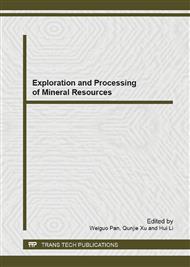p.361
p.365
p.370
p.374
p.380
p.386
p.391
p.395
p.403
The Development and Test of New Type of Hydraulic Classifier
Abstract:
Hydraulic classifier is widely used in the mill plant,But the design of traditional hydraulic classifier is simple,less controllable factors, cause the inaccuracy of Classifying product particle size,low classification efficiency. In order to solve these problems, the paper puts forward a new hydraulic classifier, we can improve the efficiency of classification by improving the appearance structure of hydraulic classifier and taking two pieces of top water. In the lab,the classification test was conducted with the coarse slime (0.9~0.3 mm, 0.3~0.074 mm) from Yanma coal preparation plant under the two phase of water supplying. The results of test show that by using two phase of water supplying, the new hydraulic classifier Can improve the classification effect of coarse coal slime.
Info:
Periodical:
Pages:
380-385
Citation:
Online since:
December 2013
Authors:
Price:
Сopyright:
© 2014 Trans Tech Publications Ltd. All Rights Reserved
Share:
Citation:


